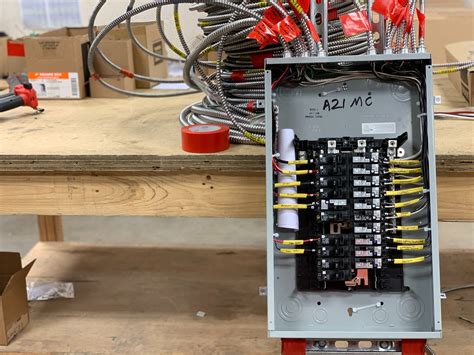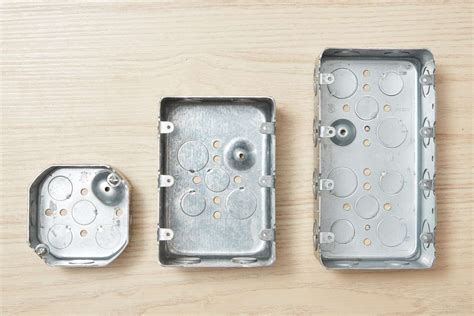electric box sizes Choosing the Right Electrical Box for Your Project. Selecting the appropriate electrical box depends on several factors, including construction, . What is a Junction Box? A junction box is simply a small enclosure for electrical connections. It protects these electrical connections from the environment around them and accidental contact. The box itself isn't anything specific. They are typically made of metal or plastic and are attached to a beam or possibly the drywall.
0 · types of electrical panel boxes
1 · types of electrical boxes uk
2 · standard size electrical boxes
3 · size of electrical outlet box
4 · exterior electrical boxes types
5 · electrical box dimensions standard
6 · dimensions of electrical outlet box
7 · different type of electrical boxes
Jump up the metal boxes and then down onto the TNT box, waiting on the metal box above the arrow box for it to explode. It'll start bouncing with you on it so just walk off to the right at the.
Choosing the Right Electrical Box for Your Project. Selecting the appropriate electrical box depends on several factors, including construction, .Electrical Boxes vary in size, material, number of gangs, and shape and are designed for specific uses like junctions, outlets, and switch or fixture boxes for wiring in wall or ceiling. Use this . Wires, receptacles and switches need adequate space. Crowded boxes can damage wires, resulting in a fire or shock hazard. You can use the chart below to calculate the . Understanding the standard sizes of electrical boxes is essential for proper installation, wire management, and compliance with electrical codes and regulations. Single gang boxes are the most common type, .
There is a huge selection of electrical boxes, varying by size, shape, mounting device, and composition. One of the first distinctions to note is that of new work boxes and remodel or cut-in boxes.
But don’t worry: Most electrical boxes fall into nine main types, specializing in a load rating tailored to specific tasks and electric appliances. 1. Metal and Plastic Electrical Boxes. The majority of electric boxes are metal or plastic. Most . Electrical boxes come in metal and plastic and in a wide range of shapes and sizes. Choosing the right size is important because it's unsafe—and illegal—to cram too many wires and devices into a box. Both plastic and metal .
The size of the box is determined by its volume which can be easily calculated by multiplying Height x Width x Length to get the total cubic inches or the volume of the box. Some boxes will have its volume listed on the box, but . Electrical boxes encase wire connections to protect them from short circuits. They are vital for fire safety and are used for receptacles, ceiling fans, outside outlets, and more. Unless the device is one of the few that contains its own wires, it likely will need an electrical box.
types of electrical panel boxes
Here we describe matching 15-Amp receptacles to 15-Amp circuits, 20-Amp receptacles to 20-Amp circuits, two-wire receptacles where no ground is present, GFCI and AFCI electrical receptacles, and the proper electrical box to hold and mount these devices. Choosing the Right Electrical Box for Your Project. Selecting the appropriate electrical box depends on several factors, including construction, wiring method, devices, location, and safety. Type of Construction. Your project’s construction type influences the choice of .Electrical Boxes vary in size, material, number of gangs, and shape and are designed for specific uses like junctions, outlets, and switch or fixture boxes for wiring in wall or ceiling. Use this guide to determine the best electrical box choice for your application.
Wires, receptacles and switches need adequate space. Crowded boxes can damage wires, resulting in a fire or shock hazard. You can use the chart below to calculate the required box size. Add up the numbers for the correspond- ing components in the box to find how many cubic inches you’ll need.
Understanding the standard sizes of electrical boxes is essential for proper installation, wire management, and compliance with electrical codes and regulations. Single gang boxes are the most common type, accommodating a single device such as a light switch or outlet.

There is a huge selection of electrical boxes, varying by size, shape, mounting device, and composition. One of the first distinctions to note is that of new work boxes and remodel or cut-in boxes.But don’t worry: Most electrical boxes fall into nine main types, specializing in a load rating tailored to specific tasks and electric appliances. 1. Metal and Plastic Electrical Boxes. The majority of electric boxes are metal or plastic. Most indoor metal boxes are steel, while indoor plastic boxes are PVC or fiberglass. Electrical boxes come in metal and plastic and in a wide range of shapes and sizes. Choosing the right size is important because it's unsafe—and illegal—to cram too many wires and devices into a box. Both plastic and metal electrical boxes are suitable for most household projects. The size of the box is determined by its volume which can be easily calculated by multiplying Height x Width x Length to get the total cubic inches or the volume of the box. Some boxes will have its volume listed on the box, but many will not.
Electrical boxes encase wire connections to protect them from short circuits. They are vital for fire safety and are used for receptacles, ceiling fans, outside outlets, and more. Unless the device is one of the few that contains its own wires, it likely will need an electrical box.Here we describe matching 15-Amp receptacles to 15-Amp circuits, 20-Amp receptacles to 20-Amp circuits, two-wire receptacles where no ground is present, GFCI and AFCI electrical receptacles, and the proper electrical box to hold and mount these devices. Choosing the Right Electrical Box for Your Project. Selecting the appropriate electrical box depends on several factors, including construction, wiring method, devices, location, and safety. Type of Construction. Your project’s construction type influences the choice of .Electrical Boxes vary in size, material, number of gangs, and shape and are designed for specific uses like junctions, outlets, and switch or fixture boxes for wiring in wall or ceiling. Use this guide to determine the best electrical box choice for your application.
Wires, receptacles and switches need adequate space. Crowded boxes can damage wires, resulting in a fire or shock hazard. You can use the chart below to calculate the required box size. Add up the numbers for the correspond- ing components in the box to find how many cubic inches you’ll need. Understanding the standard sizes of electrical boxes is essential for proper installation, wire management, and compliance with electrical codes and regulations. Single gang boxes are the most common type, accommodating a single device such as a light switch or outlet.There is a huge selection of electrical boxes, varying by size, shape, mounting device, and composition. One of the first distinctions to note is that of new work boxes and remodel or cut-in boxes.But don’t worry: Most electrical boxes fall into nine main types, specializing in a load rating tailored to specific tasks and electric appliances. 1. Metal and Plastic Electrical Boxes. The majority of electric boxes are metal or plastic. Most indoor metal boxes are steel, while indoor plastic boxes are PVC or fiberglass.
Electrical boxes come in metal and plastic and in a wide range of shapes and sizes. Choosing the right size is important because it's unsafe—and illegal—to cram too many wires and devices into a box. Both plastic and metal electrical boxes are suitable for most household projects.
4 square junction box

4 pancake electrical box
For more than 40 years, the Farris Group has been renowned for the top custom commercial contract metal fabrication in North Carolina. Utilizing the latest technology and a .
electric box sizes|exterior electrical boxes types